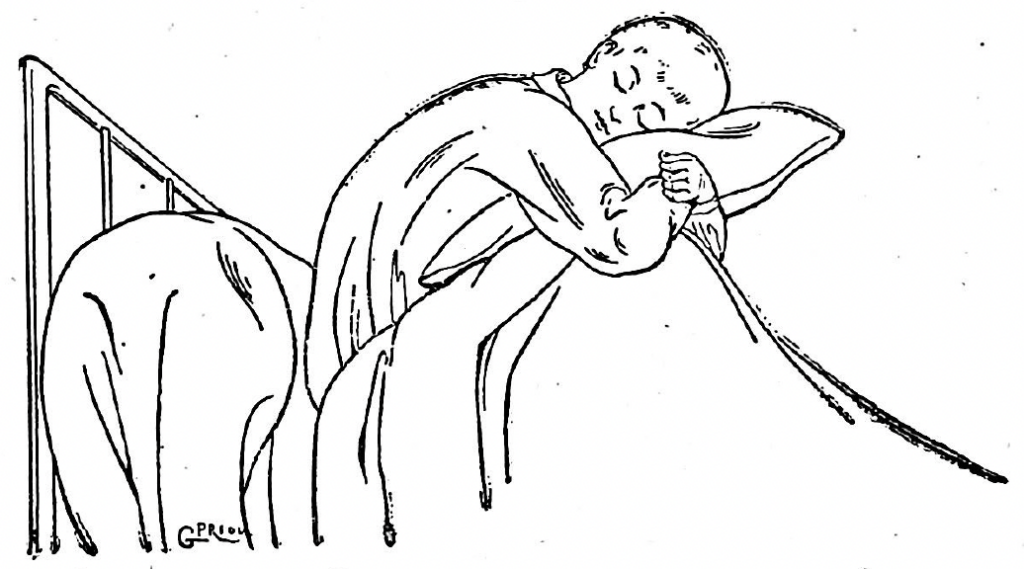Emil Pins
Emil (Elias) Pins (1845 -1913) was an Austrian physician.
Eponymously remembered for describing Pins sign I and II (1889) in pericarditis, and a musical mediastinal heart murmur (1890).
Biography
- Born on April 15 *1845 Lviv, Galicia (Lwow, Ukraine)
- 1867-1872 Medical degree at the University of Vienna
- 1873 – Assistant at the Vienna General Hospital (including ENT under Adam Politzer (1835–1920))
- Died on June 12, 1913
Medical Eponyms
Pinsschen Zeichen I (Pins Sign I) (1889)
The presence of an area of variable size with dullness in the region of the inferior angle of the left scapula associated with a corresponding area of bronchial breathing, increased fremitus and aegophony in pericardial effusions (see also Ewart sign)
Pins presented Ein neues Symptom der Pericarditis (A new symptom of pericarditis) at the Wiener Medizinisches Doctoren-Collegium meeting on January 21, 1899
Perkutirt man nämlich den in sitzender Stellung oder in rechter Seitenlage befind lichen Kranken an der linken hinteren Thoraxwand, so findet man nicht selten vom Winkel der Skapula nach abwärts den Perkussionsschall dumpf tympanitisch oder ganz leer. Dieser leere Perkussionsschall übergeht dann nach abwärts direkt in die Milzdämpfung und erstreckt sich an der Seite bis an die Axillarlinie, wo er entweder in den vollen Perkussions schall der Lunge oder in die Herzdämpfung übergeht. Am stärksten ist die Dämpfung des Perkussionsschalles an einem rundlichen, über thaler-grossen Bezirke ausgeprägt, welcher oben ungefähr drei Finger weit vom unteren Winkel der Skapula, unten zwei Finger weit vom unteren Lungenrande entfernt ist, und nach rechts von der Wirbelsäule begrenzt wird. Bei der Auskultation findet man an der Stelle der grössten Dämpfung deutliches bronchiales Athmen, der Stimmfremitus ist im ganzen Bereiche der Dämpfung verstärkt und im Zentrum derselben sogar deutliche Bronchophonie vorhanden; andere Konsonanzerschei nungen fehlen. Insbesondere ist weder Knisterrasseln noch Reibegeräusch in der gedämpften Partie nachweisbar.
If you percuss the patient in a sitting position or lying to the right on the left posterior wall of the chest, it is not uncommon to find the percussion sound muffled or completely dull from the angle of the scapula downwards. This dullness to percussion merges downwards directly into the splenic attenuation and extends on the side to the axillary line, where it either passes into the full percussion sound of the lungs or into cardiac attenuation. The attenuation of the percussion sound is most pronounced on a rounded, thaler-sized area, which is about three fingers above the lower corner of the scapula, two fingers below the lower edge of the lung, and is delimited to the right by the spine. During the auscultation, there is clear bronchial breathing at the point of greatest attenuation, the fritual voice is intensified in the entire area of attenuation and there is even clear bronchophony in the center thereof; other consonance appearances are missing. In particular, neither crackling rattling nor rubbing noise can be detected in the damped area.
Pinsschen Zeichen II (1889)
The disappearance of symptoms of pleurisy and loss of pain in patients with pericarditis when the patient leans forward to the knee-elbow position (Knie-Ellbogenlage; Knee-chest position; genu-pectorale).
Die auffälligste Veränderung sind die Ergebnisse der Perkussion und Auskultation, wenn sich der Patient in die Knie-Ellbogen-Position bewegt…Dies fällt mit der Verbesserung des subjektiven Zustands des Patienten zusammen.
The most striking change is the percussion and auscultation findings when the patient moves to the knee-elbow position…this coincides with the improvement in the subjective condition of the patient.


Pins musical heart murmur (Mediastinalgeräusch) (1890)
…ich einen Fall von musikalischem Herzgeräusch vorgeführt, der in mehrfacher Beziehung bemerkenswerth erscheint…Die musikalischen Herzgeräusche bieten wohl weniger vom therapeutischen, als vom diagnostisch-klinischen stand punkte Interesse; nichtsdestoweniger lässt sich denselben auch eine praktische Seite abgewinnen, indem die prognose ihres Verlaufes, sowie die allgemeine Prognose je nach den bedin genden Ursachen verschieden ist.
… I presented a case of musical heart murmur that appears remarkable in several respects… The musical heart murmurs offer less interest from the therapeutic than from the diagnostic-clinical point of view; nevertheless, a practical side can also be gained from it, in that the prognosis of its course and the general prognosis differ depending on the causes.
Controversies
*Date of birth varies between April 15, 1845 and April 15, 1847. The official death notice for Dr Emil Pins states he died ‘am Donnerstag, den 12. Juni 1913 im 68. Jahr seines Lebens‘. Dying in the 68th year of his life would put his date of birth as April 15, 1845
Major Publications
- Pins E. Ueber ein neues Symptom der Pericarditis. Wiener medizinische Blätter. 1889; 12: 57–8.
- Pins E. Ein neues Symptom der Pericarditis. Wiener Medizinische Wochenschrift 1889; 39(6): 209-213 and 1889; 39(7): 248-250 [Pins sign I and Pins sign II]
- Pins E. Therapeutische Wirkung des Mineralmoors und dessen Surrogate: Mattoni’s Moorsalz und Moor lauge. Wiener Medizinische Wochenschrift 1890; 40(7): 260-263 307-311
- Pins E. Neues Verfahren zur Irrigation der Nase. Wiener Medizinische Wochenschrift 1890; 40(16): 653-655
- Pins E. Ueber ein seltenes musikalisches Herzgeräusch (Mediastinalgeräusch). Wiener Medizinische Wochenschrift 1890; 40(42): 1780-1783 [Pins musical heart murmur]
References
Biography
- Eisenberg L. Pins, Emil (1845 – ). Das geistige Wien: Künstler- und Schriftsteller-lexikon. 1893: 373
- Pins, Emil (Elias) (1847-1913), Mediziner. Österreichisches Biographisches Lexikon. 1979: 75
- Czeike F. Emil Pins. Historisches Lexikon Wien. 1992; Band 4: 556
- Emil Pins. Wien Geschichte Wiki
Eponymous terms
- Review: Ein neues Symptom der Pericardits., Zentralblatt fuer die medizinischen wissenschaften. 1889
- Babcock RH. Pericarditis with effusion. In: Diseases of the heart and arterial system. 1907: 80-81
- Blechmann G. La dyspnée péricardique In: Les péricardites aiguës: avant-propos de M le Professeur Marfan. Paris: Flammarion, 1922
Internist at the Medical University of Vienna and founder of Medmastery. Master’s degree in public health at Johns Hopkins University as a Fulbright student. Passionate about teaching. | Medmastery | LinkedIn | Twitter |

